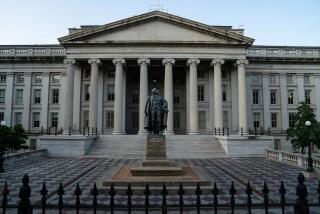Pension Woes Expected to Mount
- Share via
The Bush administration is drafting proposals to discourage companies that are struggling to pay for traditional worker pensions from dropping them, the executive director of the U.S. Pension Benefit Guaranty Corp. told Congress on Tuesday.
Steven Kandarian, whose agency insures pensions and is financed by company-paid premiums, told the Senate Finance Committee that inadequate requirements have led to a $300-billion shortfall in the assets of company plans. He said the PBGC’s record $3.6-billion budget deficit last year will deepen as it tries to rescue failing plans. “We could do nothing and hope that the system will self-correct,” he said. “This approach risks putting off today’s problems to the next generation.”
Of the companies in the Standard & Poor’s 500 index, 360 have defined-benefit pension plans, which provide annual lifetime payments to workers after they retire. Stock market declines in the last three years have caused the pension funds of companies in the S&P; 500 to lose more than $200 billion in value, according to recent studies.
Senate Finance Committee Chairman Charles E. Grassley (R-Iowa) said he was worried about the financial viability of the PBGC, which is responsible for paying part of a company’s pension obligations if the company files for bankruptcy protection.
In January, the PBGC reported an $11.4-billion loss for the fiscal year ended Sept. 30 -- the biggest in the agency’s history -- after it assumed liability for pensions at steel and airline companies that filed for bankruptcy protection.
Kandarian said his agency, along with officials from the departments of Treasury, Labor and Commerce, are working on recommendations to be submitted to lawmakers within months.
One possible recommendation being considered by Treasury would set new benchmarks for how the benefits of pensions are valued, Kandarian said. Another would toughen disclosure rules about the funding status of pension plans.
Securities and Exchange Commission officials said last week that companies were obscuring their pension losses in federal filings and giving investors incomplete information.
For example, General Electric Co. reported Friday that its pension plan contributed $806 million pretax to earnings in 2002. A footnote in its annual report showed that it actually lost $5.25 billion, equal to 29% of the company’s pretax earnings.
Grassley said he was concerned about cuts in pension benefits for workers at a time when employee-managed 401(k) plans and individual retirement accounts have lost value.
The number of traditional pension plans has declined from more than 111,000 in 1987 to about 30,000, Grassley said. “This decline in the number of defined-benefit pension plans is bad for Americans,” he said. “We ought to be looking at ways to encourage sponsorship of defined pension plans.”
Kandarian told the panel that although his agency faces long-term deficits, it isn’t at risk of running out of cash right away.
When the PBGC is forced to take over under-funded pensions, other companies with covered plans must bear the cost, he said. Over time, strong companies with well-funded plans may choose to leave the system.
The agency includes on its books “probable losses” totaling $5.2 billion from the pension plans of two steel companies that have sought bankruptcy protection: National Steel Corp. and Bethlehem Steel Corp.
“We expect that our deficit may increase dramatically,” Kandarian said.
More to Read
Inside the business of entertainment
The Wide Shot brings you news, analysis and insights on everything from streaming wars to production — and what it all means for the future.
You may occasionally receive promotional content from the Los Angeles Times.










